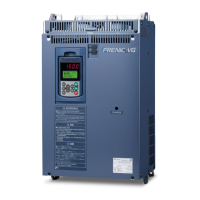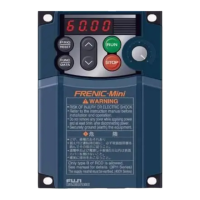6.3 Synchronous Motor Drive PG Interface Card
6-43
Chap. 6
CONTROL OPTIONS
6.3 Synchronous Motor Drive PG Interface Card
OPC-VG1-PMPG/PMPGo
6.3.1 Product overview
Using this option allows the FRENIC-VG to drive a synchronous motor. When
detecting magnetic pole positions using only the Z-phase, use the OPC-VG1-PG
(SD) option. Synchronous motors offer advantages over induction motors in the
form of their smaller size and lower energy consumption. Used in combination
with this option, the FRENIC-VG can drive not only Fuji motors (GNF2 series
motors, ES motors, and AC servomotors), but any synchronous motor with a
compatible encoder interface. However, it cannot be used with motors that utilize
serial encoders such as Fuji's FALDIC dedicated motor. Choose the
OPC-VG1-PMPG for line driver output or the OPC-VG1-PMPGo for open
collector output.
(1) Maximum rotational speed of 30,000 r/min.
The synchronous motor drive PG interface card can generate output at up to 800 Hz when using a
carrier frequency of 10 kHz, allowing it to drive a motor at up to 30,000 rpm with a 2P motor
conversion. However, in fact the encoder's input frequency is limited to 100 kHz. For example,
using a 256P/R encoder, the card can drive a motor at up to 100 kHz / 256 × 60 = 23,438 r/min.
(2) Magnetic pole position interface
The card can drive a motor with an encoder interface that satisfies the following specifications:
1) Synchronous motors that output magnetic pole positions using 4-bit Gray codes
2) Synchronous motors that output magnetic pole positions using 3-bit codes (U-, V-, and W-phase)
(3) Broken wire detection function
The card can use the broken wire detection function. When a broken wire is detected, the inverter
will display alarm
p9
and shut off its output, causing the motor to perform a free-run stop.
However, this function cannot be used with the open collector output model (OPC-VG1-PMPGo).
The FRENIC-VG's PG broken wire detection cancelation function can be used in the standard
configuration.
(4) Synchronous motor, ES motor, and AC servomotor drive
The synchronous motor drive PG interface card can drive Fuji synchronous motors (GNF2), ES
motors (GRK2), and AC servomotors (GRH). The user need only set several motor parameters.
When driving GRK series motors, choose the PMPGo card, since the included encoder generates
open collector output. In this application, be sure to attach a zero-phase ferrite ring to counteract
line noise.
(5) Small-capacity motor drive
The FRENIC-VG line starts with inverters rated for 0.75 kW in a 200 V circuit. However, these
inverters can also drive 0.2 kW and 0.4 kW synchronous motors. The user need only set several
motor parameters.
(6) IPM and SPM motor drive
Synchronous motors are classified as either internal permanent magnet (IPM) or surface permanent
magnet (SPM) devices, depending on the method with which the magnetic poles are incorporated
into the motor. The FRENIC-VG can drive both types. In particular, it is possible to set the salient
pole ratio using function codes. This capability allows the motor's reluctance torque (torque that
takes advantage of differences in magnetic resistance) to be used, increasing efficiency.

